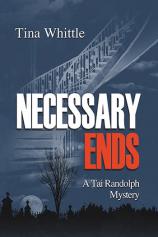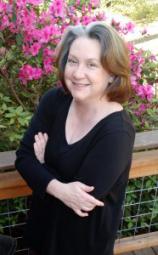Author Talk: April 11, 2018
Tina Whittle is the author of a series of Atlanta-based mysteries featuring intrepid gun shop owner Tai Randolph and her corporate security agent partner, Trey Seaver. In this interview, Whittle discusses the challenges of writing a series and how she researched the details about filmmaking that are central to the sixth and latest installment, NECESSARY ENDS. She also explains why she chooses not to outline her novels and feels more comfortable as a “dyed-in-the-wool pantser,” making up the plot by the seat of her pants, and reveals some of her primary writing influences.
Question: Was this sixth entry to the Tai Randolph series easier to write than the first couple, now that you have become more practiced as a novelist?
Tina Whittle: The answer should be yes. And yet...no. Every single book is harder than the previous one. It's easy to feel as if this is a failing specific to me, but I know it's not. According to author Thomas Mann, a writer is someone for whom writing is more difficult than it is for other people. I seem to get more writerly every year.
In my defense, my characters are becoming much more complicated because I've spent six books opening up their backstories and plumbing their psychological depths. I am only now discovering the real skeletons in their closets. Also, the research load is heavy, especially in the areas of neuroscience and law enforcement, and my series "bible" is becoming as convoluted as a real-life genealogical chart. Each book now carries the weight of all that has gone before even as it builds the foundation for the book to come. So I try to cut myself some slack that I'm not even close to being an expert novelist. I'm grateful that, despite the challenges, writing this series is still utterly satisfying work.
Q: NECESSARY ENDS picks up directly from the events in RECKONING AND RUIN, published in 2016. Do you have to outline in extreme detail to keep all of the elements aligned properly, or are you able to work through the plot by improvising as you go?
TW: Six books into this writing gig, I have grown comfortable with the fact that I'm a dyed-in-the-wool pantser (a writer who doesn't outline, who makes up the plot by the seat of her pants). Early in my career, I tried to change that, to become more efficient and orderly. I bought a book entitled YOU CAN WRITE A MYSTERY. I followed its plan step by step, and it was a good plan, but there was no spark to the process, no creative kindling.
The blank page provides a place for my characters to talk. They argue, and I glimpse the inherent conflict. They share clues with each other, and the plot slowly reveals itself. The very first scene I write is the end --- that provides my north star. Then I write scene after scene after scene, usually about twice as much as I need to, and somehow in that patchwork crazy quilt of happenings and realizations, I find the backbone of the story. I have a sticky note up beside my desk that reads, "Keep Writing. It Will Come." And so I do. And so it does.
Q: This book revolves around the bad practices that surround a movie being filmed in the Atlanta area. How did you research all of the details about filmmaking that read so convincingly here?
TW: Here in Georgia, we're surrounded by Hollywood --- more feature films were made here last year than any other place in the world (including California and New York). You can't spit without hitting an actor. A few years ago, I almost ran over Clint Eastwood. He was filming in this back alley in Savannah, and I accidentally drove my car onto his set. I was immediately surrounded by security, as was he, and no harm came to either of us. But I've learned to keep a keen eye out for those yellow signs that mark the physical boundaries of a live movie set. And I hope his crew has learned to make said signs much more visible.
I'm also lucky to have actors and theater professionals in my circle of friends. They provide behind-the-scenes details, share tidbits that only working professionals could know, and occasionally lend their special effects talents should I need to blow something up (as I did in the second book in the series, DARKER THAN ANY SHADOW). Every mystery writer needs an engineer, a cop and a technical director in her consultant pool, and I am incredibly lucky that my sources are patient and generous.
Q: The romantic relationship between Tai and Trey Seaver, the former SWAT officer who suffered a grievous injury, is given nearly as much space here as the crime case. Do you feel your readers expect this kind of equal division between romance and mystery?
TW: Actually, I don't think my readers see a division at all. I suspect that, like me, they see the crime solving my co-protagonists do together as a natural extension of their relationship. Tai and Trey bring very different strengths to sleuthing --- Tai is intuitive, quick-thinking, and good at sussing out motives and secrets, while Trey is steady, intellectual and excellent with data. She works gray zones; he works rules. Their complementary skill sets make them a very effective investigative team, but the differences trigger their personal conflicts. They tend to be over-protective of each other, which sometimes leads to unhealthy behaviors like lying (Tai) and stalking (Trey). The negotiation that these two strong-willed individuals must engage in is the glue that holds both their working partnership and their romantic relationship together.
In NECESSARY ENDS, this dynamic gets switched up a bit. Usually Tai is the initiator in the case, the one who decides to begin an investigation. But my editor Barbara Peters and I were talking, and she suggested that perhaps it was time that Trey got a case, something juicy enough to make even a rules-and-regs man like Trey want to take justice into his own hands. Once I discovered the inciting incident, I realized that this reversal in their sleuthing relationship would test their personal connection, too.
It's also a challenge to Trey's self-conception. After he suffered the TBI (traumatic brain injury), he retreated into himself. No longer able to work as a police officer, he lost his identity as an agent of justice in the world. Now that commitment is back, with Tai being an inextricable part of his psychological renewal.
Q: Who have some of your primary writing influences been, first as a mystery reader, and now as a crime novelist?
TW: I developed a taste for mayhem in elementary school, sneaking over to the side of the library I wasn't supposed to be on so that I could read Edgar Allan Poe and Agatha Christie. If it was spooky or gory or had a corpse at the bottom of the well, I wanted to read it. I enjoyed more age-appropriate fare as well --- Nancy Drew and Trixie Belden being my favorites --- but there was something deliciously transgressive about the darker tales, the ones with bloody murder in the first chapter. I blame my Southern upbringing for my macabre taste; storytelling of the more gruesome variety runs in our veins down here.
And while I read across many genres, mysteries remained my favorite, especially the ones with female protagonists. Strong and opinionated and take-no-prisoners smart characters, like Marcia Muller's Sharon McCone, Sara Paretsky's V.I. Warshawski and Sue Grafton's Kinsey Millhone captured my mystery-loving heart. At the time, I didn't consider how radical these protagonists were, how much their presence changed the crime fiction landscape. I also love the work of Southern writers Mary Hood, Barbara Kingsolver and Lee Smith. Their stories were a master class in the art of the telling detail, how the whole cloth of a person's soul can be revealed in one small gesture. They taught me the difference between truth and fact. Every word I write is an homage to them.




